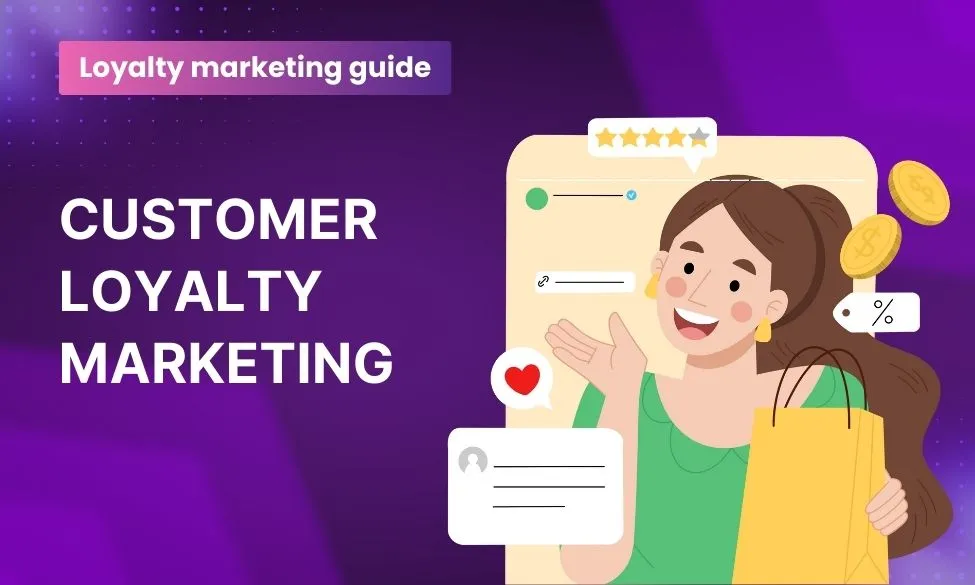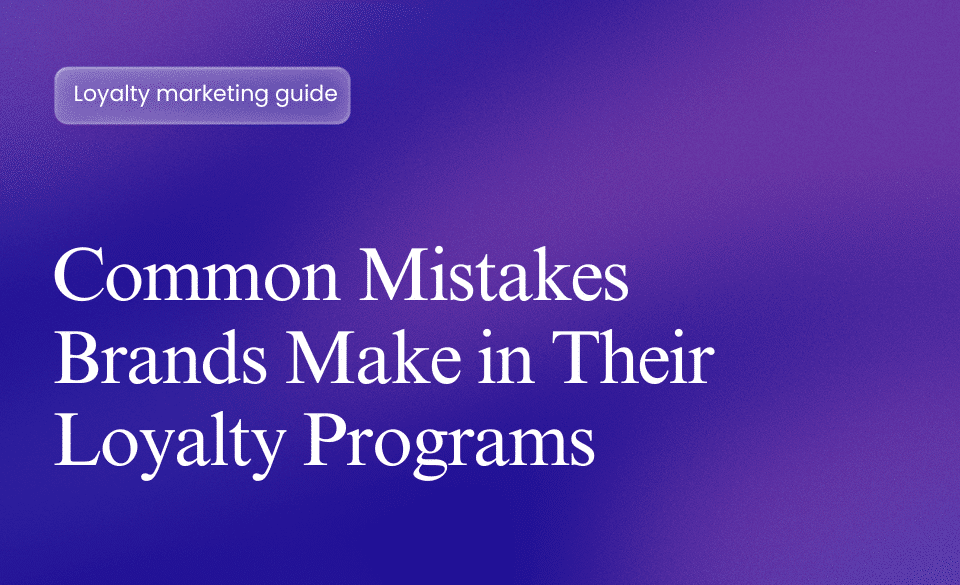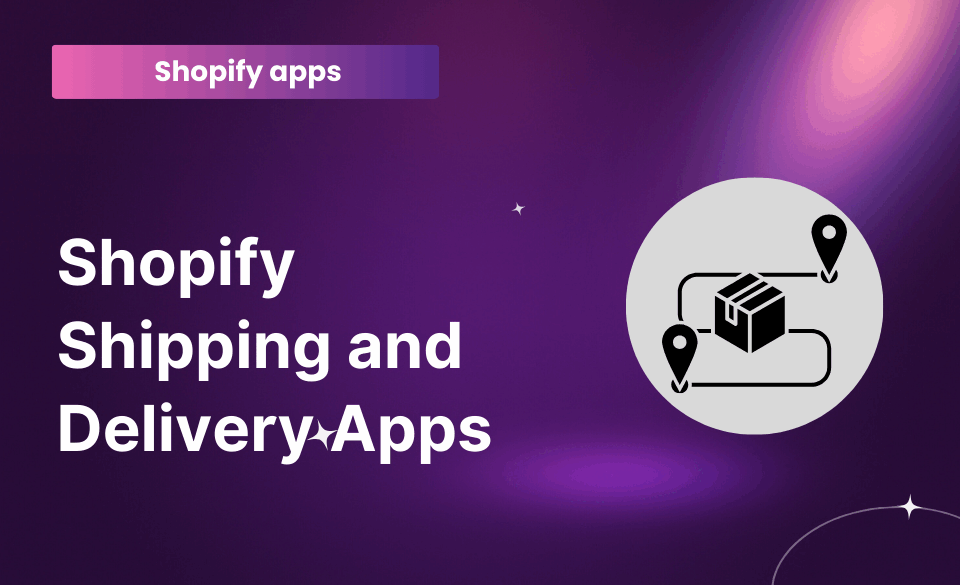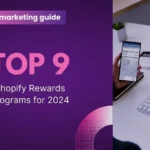
Top 9 Shopify Rewards Programs For 2024
16 July, 2024
Small Business Referral Program: Best Practices & Best Examples
26 July, 2024Customer loyalty marketing helps organizations of all sizes build brand supporters. Wonder how loyalty marketing can transform your customer retention efforts? Your answer is here!
This guide reveals what loyalty marketing is, its benefits, and more.
Understanding Customer Loyalty Marketing
Let’s learn more about loyalty marketing and how it can change the way you interact with your customers.
Definition Of Loyalty Marketing
Loyalty marketing is a marketing approach that meant to keep and increase revenue from current consumers.
Imagine you have a lemonade stand. You want kids to keep coming back to buy your yummy lemonade, right? Loyalty marketing is like giving those kids a special card. Each time they buy a lemonade, they get a stamp on their card. Once they collect enough stamps, they get a free lemonade. That way, they’re more likely to return to your stand instead of going to someone else’s.
Loyalty marketing in stores works the same way. Stores give you points or rewards for buying things. The more you buy, the more rewards you get You want to keep shopping at that store to earn more.
Key Concepts In Customer Loyalty Marketing
Loyalty marketing is like having a special club for your best customers. Here are some important things about this club:
- Customer Journey:
This includes everything a customer does with your brand, from when they find you to when they leave a review and maybe even after that. Loyalty marketing aims to make the whole experience enjoyable and worthwhile.
- Emotional Connection:
Giving deals isn’t the only way to use loyalty marketing. It’s about making your people feel good and special in your relationship with them. Some ways to do this are to provide great customer service, personalize deals, and create a sense of community.
- Customer Retention:
This means keeping people you already have and getting them to come back for more. Customers are less likely to switch to a competitor if rewarded for buying from you again.
- Customer Lifetime Value (CLTV or LTV):
This is the overall profit you expect from customers during their association with your business. Loyalty programs can help boost CLTV by keeping customers interested and making them spend more over time.
- Brand Preference:
The main goal of loyalty marketing is to get people to pick your brand over others. By giving customers trust and good experiences, you can turn them into loyal customers who always choose your products or services.
This fosters trust and strengthens their preference for your brand over competitors.
Benefits Of Loyalty Marketing
We’ve shown loyalty marketing builds long-term consumer connections. But the real question is: what’s in it for business owners? Here are the answers for you.
Improved Customer Retention
One of the best things about loyalty marketing is that it can help keep customers longer. Dollar Shave Club’s loyalty program best shows this strength. According to a Narvar survey, 83% of Dollar Shave Club U.S. customers expect frequent buy contact, up from 75% last year.
In just five years, they have attracted three million return buyers by building a community where everyone feels they belong.
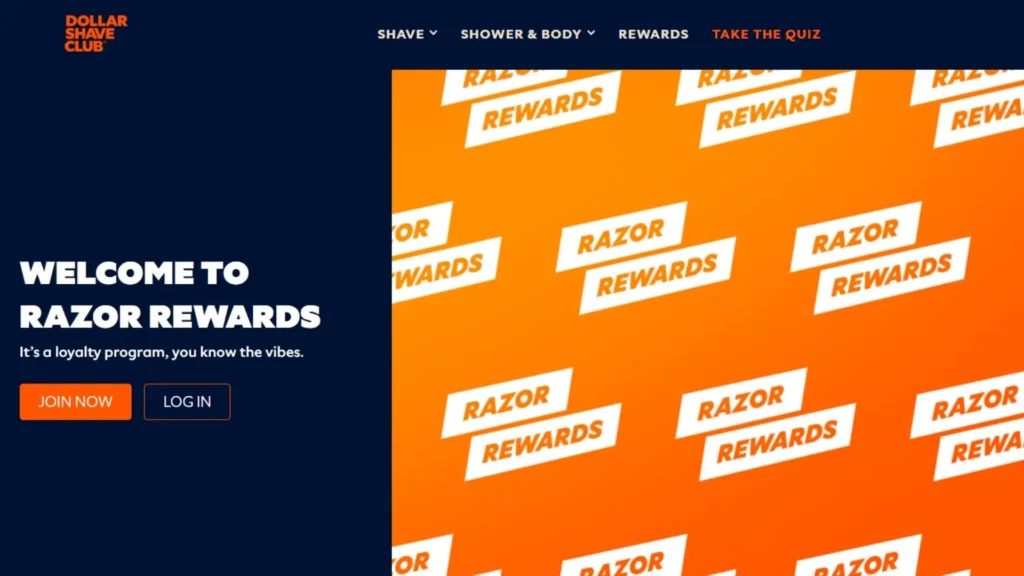
This shows how powerful customer loyalty marketing can be. People are more likely to buy from you again, and you can also cross-sell and up-sell.
Enhanced Customer Engagement
Loyalty programs are a secret weapon for keeping customers deeply engaged with your brand. Statistics show that 48% of US survey participants joined a brand loyalty program to express their devotion to the brand. That’s a strong feeling of community, and connection comes from loyalty programs that go beyond just purchases.
Let’s say you run an online shoe shop with a program that gives points for every buy. Customers can use these points to get deals, special goods, or early access to new versions.
But why stop there? You may include aspects of gamification in your program. It includes reward badges for accomplishing tasks like posting about purchases on social media or leaving reviews for products. These playful elements add a layer of fun and incentivize further engagement, propelling your customers from passive participants to active brand champions.
Increased Sales And Revenue
Federated Reichheld’s research shows a strong link: keeping customers for an extra 5% of the time can lead to a huge 25% increase in sales.
Let’s look at the Sephora case study as a real-world example. There are an amazing 17 million users of Sephora’s Beauty Insider program in North America. These loyal customers make up 80% of Sephora’s sales. Their loyalty program encourages interaction, so customers stay in touch even when not shopping.
This boosts Sephora’s revenue by 22% in cross-selling and 13-51% in upselling due to its engaged devoted consumer base.
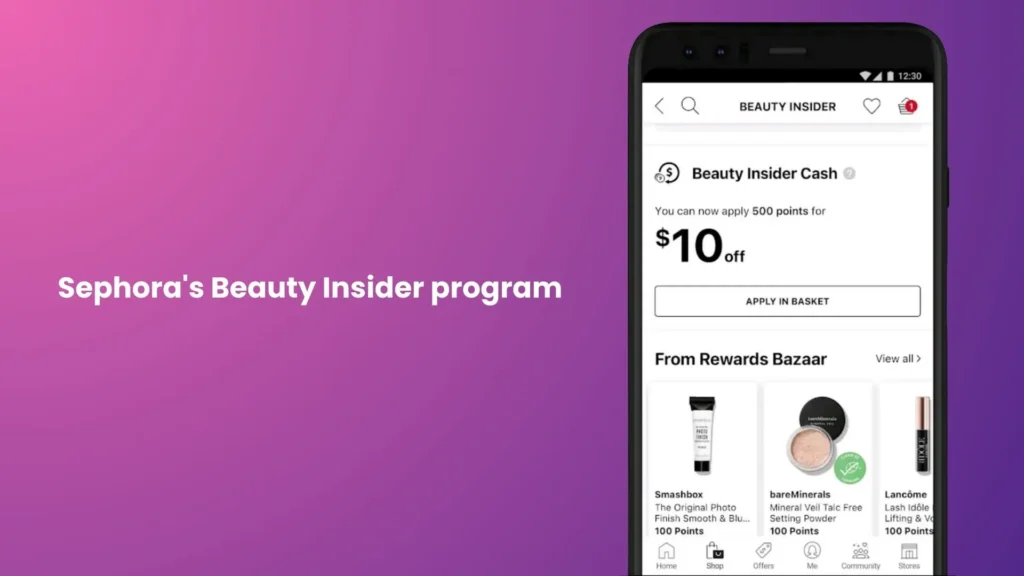
Effective Loyalty Marketing Strategies
After learning about customer loyalty program’s benefit, it’s time to design a successful program. Don’t worry, this part will show you a few fundamentals and customizing them to your brand and audience. You can design a loyalty program that consumers love and gets results.
Personalized Customer Experiences
Epsilon’s study shows that 80% of customers are more likely to buy from a company that provides a personalized experience. It all makes sense now. Customers are more likely to connect with a program that understands their needs and interests.
Personalization is a lot more than naming someone in an email. Here are some useful ways to make your reward program more personal:
- Tiered Loyalty Programs: Offer customers different types of rewards based on their engagement. Your best customers may receive early access to specials or tailored birthday presents like Arken Optics does.
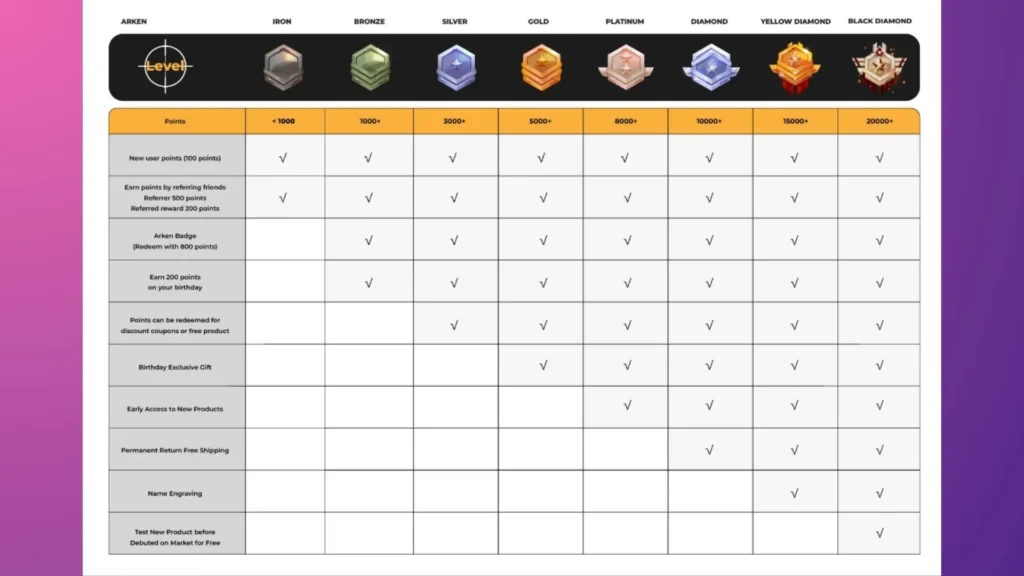
Dynamic Content: Use information about your customers to suggest products on your website so that each customer sees the best deals.
- Personalized Communication. Instead of general emails, send notes specific to the customer based on their tiers and hobbies. For example, Sephora’s Beauty Insider sends email notifications of new rewards only to Rouge members.
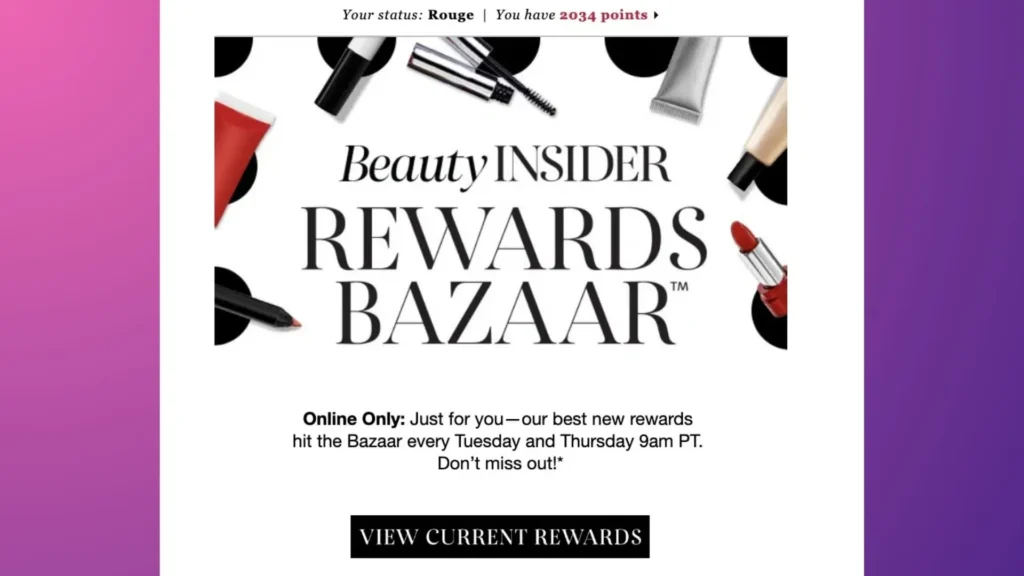
Using these tips, you can create a reward program that makes each customer feel special and important. This encourages greater involvement, which leads to more trust, and a successful business.
Choose the right type of loyalty programs
Here’s a breakdown of some rewards structure (points, tiers, etc.), along with inspiring success stories:
Point-Based Programs:
This is a traditional and often-used strategy. Customers may redeem buy points for gifts, reductions, or unique experiences.
One point-based method is Starbucks Rewards. You may get a “Star” with every purchase.
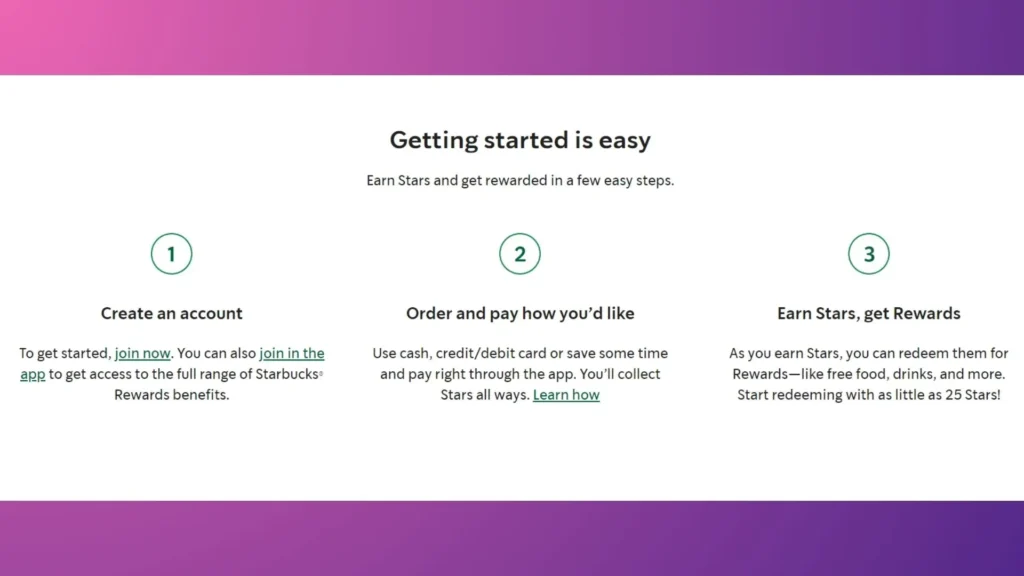
2. Tiered Programs:
It’s possible for members to get more points or better rewards as they move up the ranks. This makes them spend more and feel that they’re the only ones who can have what they want.
For example, Sephora’s Beauty Insider is a tiered program that offers first-class access to its products.
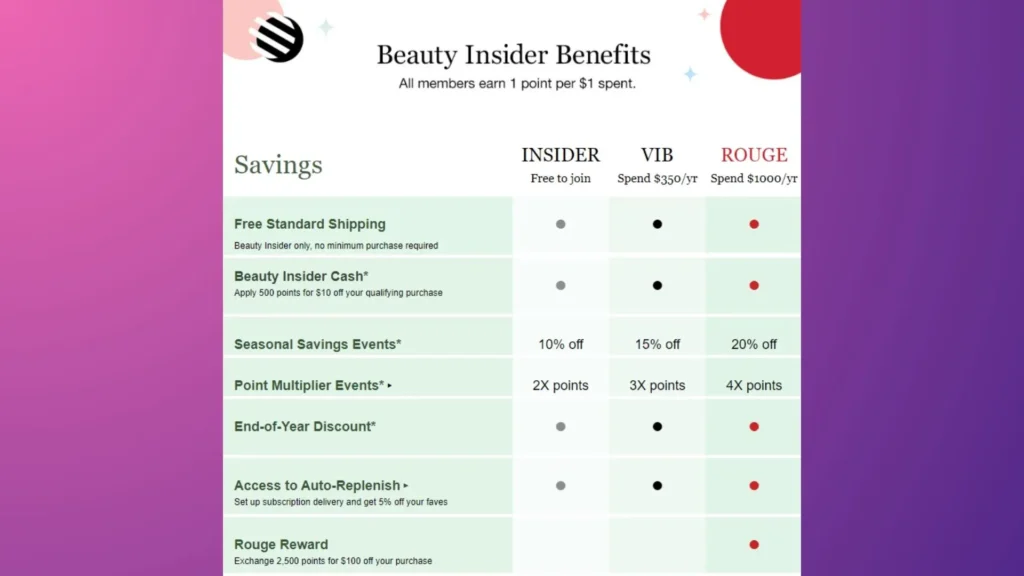
3. Paid Customer Loyalty Programs:
This type gives you access to extra perks for a monthly fee. It’s perfect for companies with loyal customers willing to spend money on a better experience.
Take inspiration from the well-known US bookshop Barnes & Noble. There are two levels: B&N Rewards (free to join) and Premium Membership (paid).
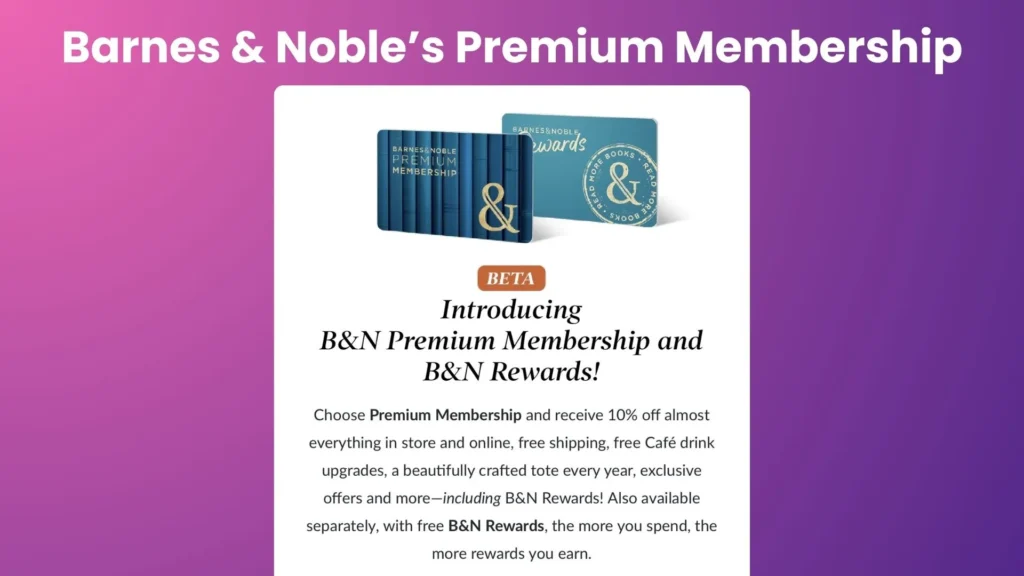
4. Gamification:
Points, badges, and leaderboards—game elements—draw players in on this tactic. One well-known online retailer for chic ladies in sizes 12 to 32 is Simply Be. They give out member-only prizes every month.
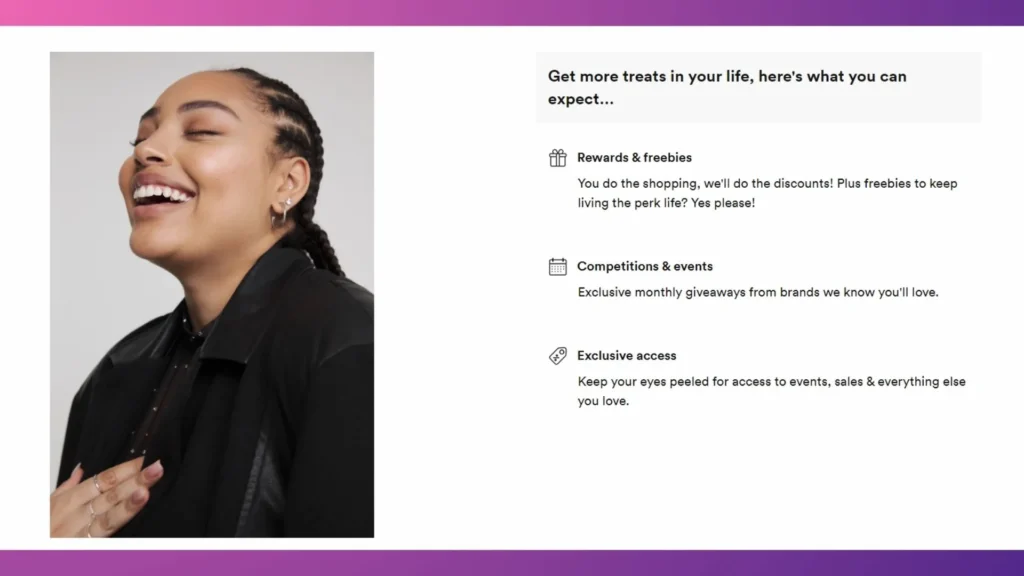
Knowing these possibilities and looking at successful ones will help you choose the ideal loyalty program for your target market and company objectives. Make sure your program stresses exclusivity and value to boost consumer loyalty.
>>> Read more in this blog, “How to Set Up the Best Loyalty Program for Your Ecommerce Store“.
Customer Feedback And Continuous Improvement
Step 1: Collecting and analyzing customer feedback.
Continuous growth is based on actively getting feedback from customers and analyzing it. Customer loyalty programs are a great way to get useful information. A lot of information about how customers feel can be gathered from:
- Surveys.
- Polls are built into the program.
- Social media tracking.
The Ritz-Carlton Hotels exemplifies this approach. They strategically place polls in guest rooms and send follow-up emails, actively seeking guest feedback on their stay.
Step 2: Using feedback to improve products and services.
Once you have useful feedback, it is important to turn it into changes you can make. Look at the comments to find themes that are areas for improvement.
Ritz-Carlton Hotels, for example, are known for having great customer service. To show their appreciation, they give their workers up to $2,000 in buying power to solve guest problems on the spot. This lets problems be fixed right away and encourages a mindset of happy guests.
Examples Of Successful Loyalty Marketing
Ready to see loyalty marketing in action? Let’s take a global tour and examine some actual instances of companies that have perfected the art of winning over devoted customers.
Big Brands And Their Loyalty Programs
The famous coffee shop chain Starbucks has a Starbucks Rewards program that lets customers earn “stars” for every buy. You can exchange these stars for free drinks, food, or special things. The program’s popularity comes from its ease of use and the chance to win rewards every time you visit.
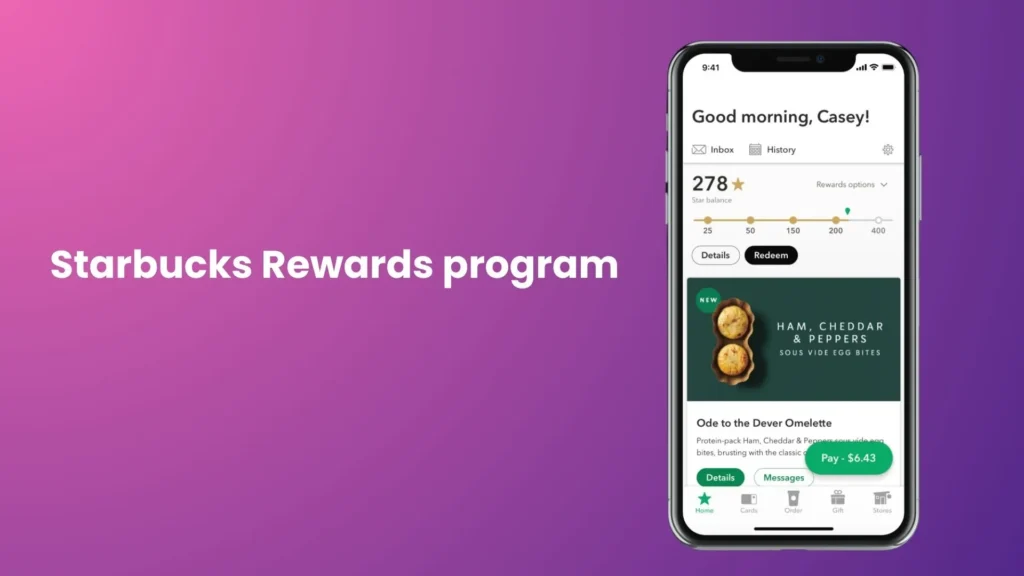
According to Starbucks’ Q2 Fiscal 2024 Results, there are now 32.8 million regular members in the U.S., up 6% from last year. This shows that customers are interested and that the program could lead to more sales in the future.
>>> Read more:
Lessons from Starbucks loyalty program for Shopify store 2024.
Small Businesses And Innovative Approaches
Big brands like Starbucks have the edge of being well-known, but small businesses can still do great things with rewards programs. Here are some examples that will inspire you:
Case Study 1: Özel Beslenme using BON Loyalty to create its loyalty program.
Even though Özel Beslenme had a huge selection of health and fitness products, it had difficulty keeping customers. Their first rewards program didn’t get people involved. And their stock was so fragile that it made return purchases a worry.
Solution: Özel Beslenme put BON Loyalty’s app into action, which provides an easy-to-use interface with digital discounts and other features. This made it easier to redeem rewards and got customers more involved.
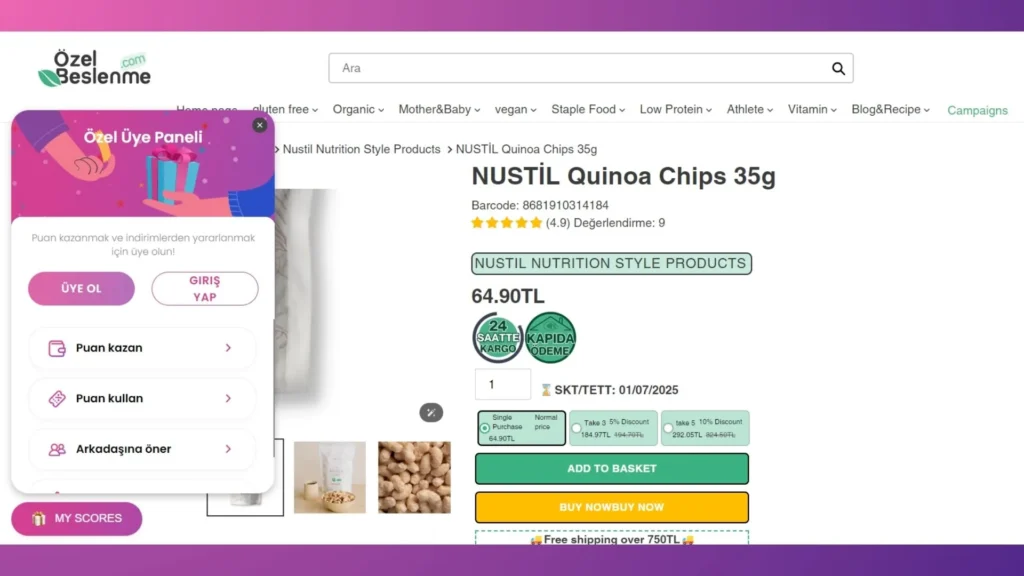
Results: In one quarter, more than 500 rewards were redeemed, which brought in about $13,000 in sales, a big 6% increase in sales.
The story of Özel Beslenme shows that choosing the right reward program partner can have a big effect on sales and customer involvement. Even for businesses that face unique problems.
Case Study 2: The Coffee Bean Rewards uses punch card 2.0:
A coffee shop called The Coffee Bean uses a reward app. Customers no longer use heavy paper cards to keep track of their progress toward free drinks and sweets. Instead, they use their phones.
The main point? For small businesses to have successful loyalty programs, they need to know their customers well and make the programs feel special and satisfying. These new ideas will help you connect with your customers better, increase sales, and do all this without spending much money.
Tips For Implementing Loyalty Marketing In 2024
The way members use rewards programs will be affected by many important trends. It is important to understand these trends to make a program that works in today’s world.
In this section, we’ll discuss the factors that influence the implementation of loyalty programs.
Pro Tips 1: Leveraging Data Analytics
Data may help you understand your customer’s purchasing behavior and preferences. Key indicators to keep track of include:
- Active member rate: This shows the proportion of members that earn or redeem rewards within a certain period. A high active member rate indicates a customer-motivating program.
- Redemption rate: This shows which part of users’ points or awards are actually used.
- Repeat buy rate: This number shows the portion of people who buy from you again after joining your reward program.
- Loyalty program ROI (Return on Investment) measurement: It compares your loyalty program’s financial return to its expense. Positive ROI means the program is profitable.
- Net Promoter Score (NPS): While not specific to loyalty programs, NPS may indicate consumer satisfaction. A high NPS indicates client satisfaction with your program.
>>> Explore more: Top 10 Customer Loyalty KPIs Businesses Should Track.
These metrics allow leveraging customer data and analytics to optimize your loyalty program.
Loyalty program management platforms (LMPs) control key functions such as member administration, point tracking, award redemption, and campaign design. Popular choices include:
- BON Loyalty (Easy customized rewards, integrates with Shopify).
- Yotpo (Loyalty program with an emphasis on reviews and referrals).
- Punchh (Flexible platform for various industries).
- Bluedot (Omnichannel loyalty with gamification features).
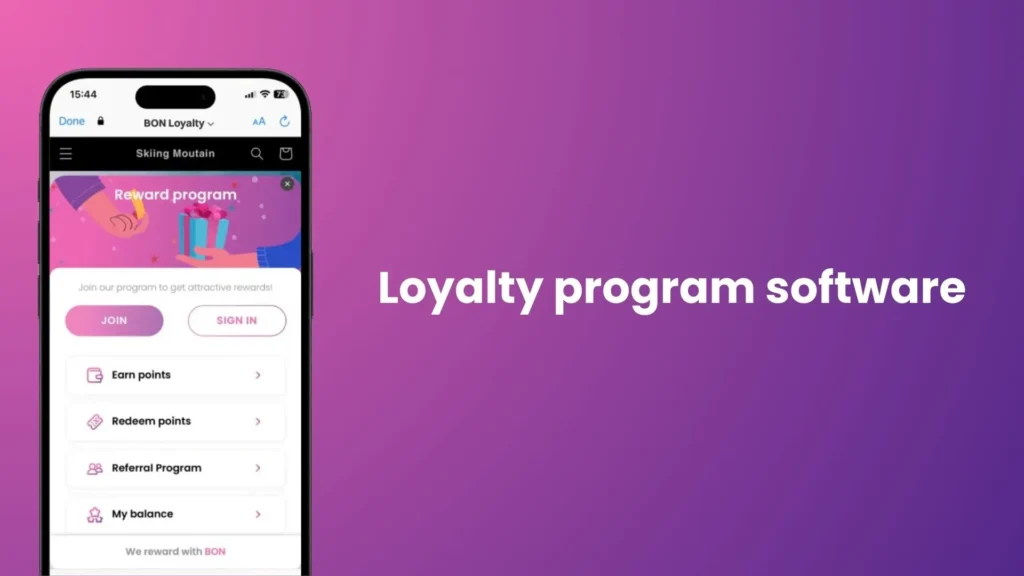
Choosing the right loyalty program software for your business needs. Choose with your industry, customers, and desired software features in mind. Investigate free trials and demonstrations without delay to locate the ideal match.
>>> Read more: 13+ Loyalty Management Software.
Pro Tips 2: Creating A Seamless Omnichannel Experience
According to Invesp research, businesses that excel in omnichannel strategy keep 89% of their clients, compared to only 33% of those who struggle.
Why the big difference? Today’s customers expect a smooth experience across online and offline channels. Whether browsing your website, visiting your store, or following you on social media. A loyalty program that feels disconnected is a missed opportunity.
Here’s how to create a seamless omnichannel loyalty program experience:
- One Membership for Everything. Make life easy for your customers with a single membership system. They should be able to access their account, points balance, and reward information no matter how they interact with your brand.
- Multi-Channel Earning: Give customers more ways to earn points and rewards. This could include online purchases, in-store visits, or social media engagement.
- Omnichannel Redemption: Allow customers to redeem rewards across various channels. For example, points earned online should be redeemable in-store, and vice versa.
Using these tips, you can create a loyalty program that makes your customers feel useful no matter how they connect with your brand.
Pro Tips 3: Building Emotional Connections With Customers
Harvard Business Review research shows that feelings have a big effect on customers’ actions. Customers are more likely to be loyal to a brand if they have a strong personal connection to it.
So, how do you tap into this emotional connection superpower? Here are some ideas:
- Share Your Story:
Inform your clients about your brand’s meaning and the reason behind what you do. People are more likely to be loyal if they believe in your goal.
For instance, Patagonia’s fight for environmental causes resonates deeply with its customers.
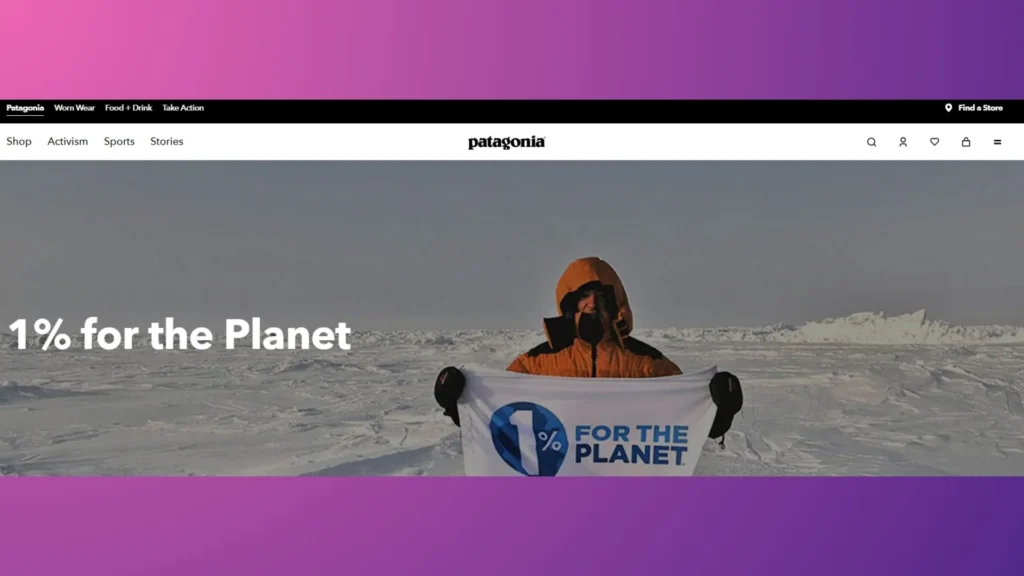
- Focus on Customer Experiences:
Do more than just sell something. Give your people fun and lasting encounters. Olive Garden is a great example of this. Members of their eClub get free birthday food or cake. It adds a nice touch to their dinners for fans.
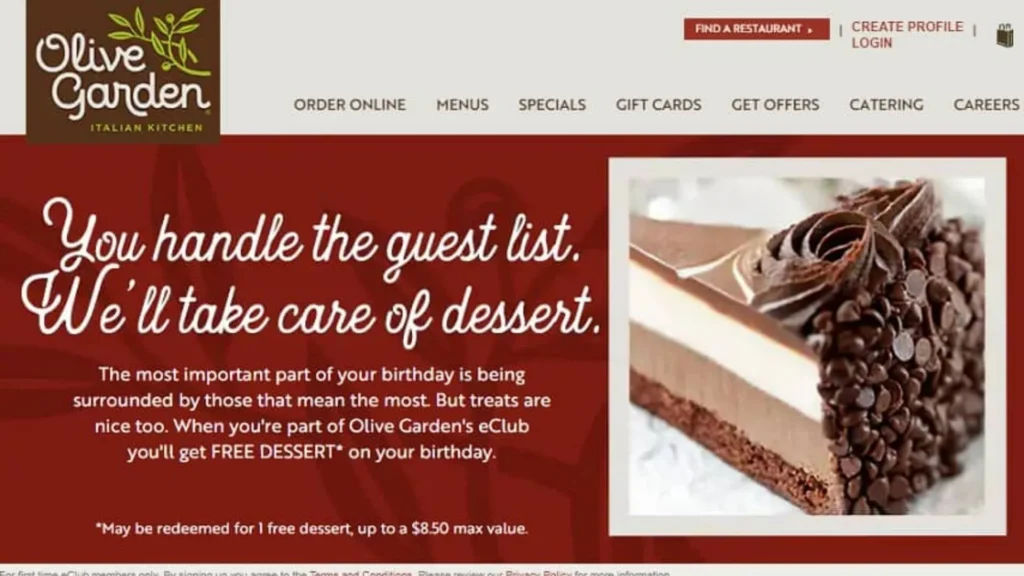
Patagonia donates 1% of sales to environmental protection.
- Show Appreciation:
Thank yous are quite basic and may go a long way. Offer your loyal customers a little present as a thank you for picking you. Just thank them for their business or provide exclusive offers and benefits just to members.
Airlines like Southwest Airlines often do things to thank customers who fly with them often.
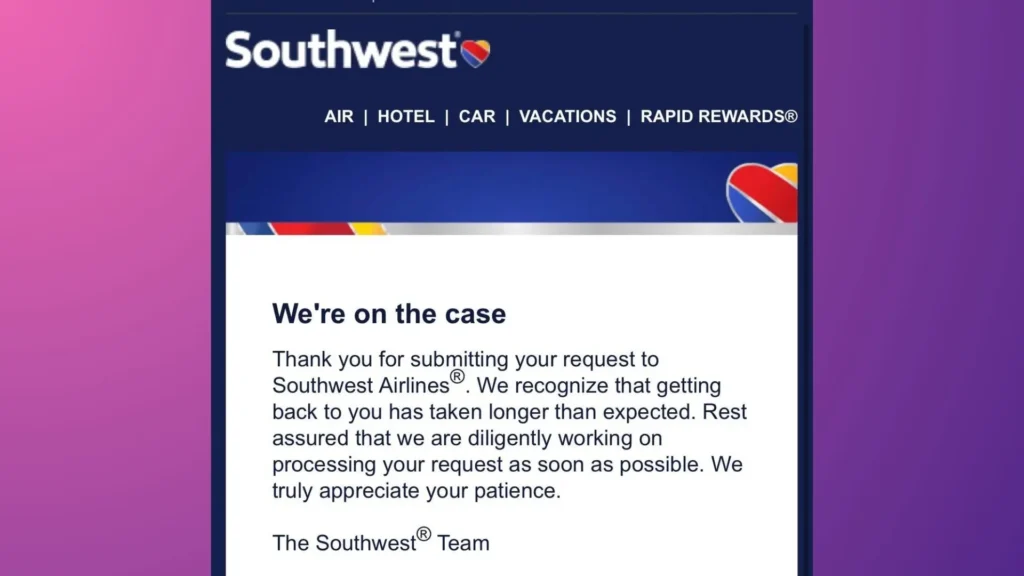
Frequently Asked Questions (FAQs) About Loyalty Marketing
What is the difference between loyalty marketing and customer retention?
Loyalty marketing involves emotional connection and incentives and perks to encourage repeat purchases. The objective is for satisfied consumers to grow into ardent brand advocates.
Customer Retention tries to prevent customers from switching to competitors by keeping the ones they already have. Plans are in place to keep customers happy and address any problems that could cause them to leave.
Both methods are important for businesses. A strong customer retention program lays the foundation. A well-designed loyalty program can take customer relationships to the next level.
How can small businesses start a loyalty program?
Here are two cost-effective ideas to get your small business loyalty program up and running:
Leverage Third-Party Loyalty Platforms:
Consider using existing loyalty program apps (like BON Loyalty for Shopify stores). This can help you get your program up and running quickly while saving you money and time on development.
Read more: 5 best digital loyalty programs for small businesses.
Start Simple:
Begin with a basic program that’s easy to manage and understand for you and your customers. Here are a couple of simple ideas:
- A points system, like a single point per dollar spent, is a common starting point.
- A referral program is a great way to gain new customers organically and leverage the trust your existing customer base has built with you.
Focusing on involvement and giving rewards, even small, can help you build a loyal customer base that keeps returning for more.
What are the key metrics to measure the success of a loyalty program?
Tracking enrollment rate, activity rate, frequency of interaction, customer lifetime value, and repeat purchase rate may help you assess your loyalty program’s performance and influence on your company goals:
- Enrollment Rate: This tells you what part of your customers sign up for your reward program. If few people sign up for a program, it might not be very interesting or simple to understand.
- Activity Rate: The percentage of members that earn or redeem incentives in a given time. High member activity implies a customer-motivating program.
- Frequency of Interaction: Your program’s use rate—logging in, checking points, and redeeming rewards—is shown here. A program with high engagement frequency keeps clients engaged.
- Customer Lifetime Value (CLV): This measure evaluates your organization’s lifetime customer income. Increased CLV indicates a successful loyalty program.
- Repeat Purchase Rate shows how many customers purchased again. A rise in the number of return purchases shows that the program is making customers more loyal.
These important data and consumer feedback may provide you with a complete picture of your loyalty program’s performance.
Advanced Loyalty Marketing Techniques: Gamification in Loyalty Programs
Gamification is the newest way to get people really interested in your business. Gallup studies show that it can actually make people 60% more interested and 63% less likely to leave your business. Why? The drive to fight, succeed, and be noticed is deep inside all us, and gaming plays on that.
So, how does it work? Imagine your loyalty program with features like:
- Points & Badges: It’s nice to get points for purchases, and it’s even better to get badges for meeting goals. Customers stay inspired to join because they feel like they’ve accomplished something.
- Fun leaderboards keep consumers interested by encouraging them to climb higher positions.
- Challenges & Quests: Customers stay interested by completing set tasks or certain actions that lead to new prizes.
- Progress bars and new levels with further bonuses motivate and reward them.
Get inspired by Sephora’s Beauty Insider. They made a community where people are given badges and are ranked every month based on how much they contribute.
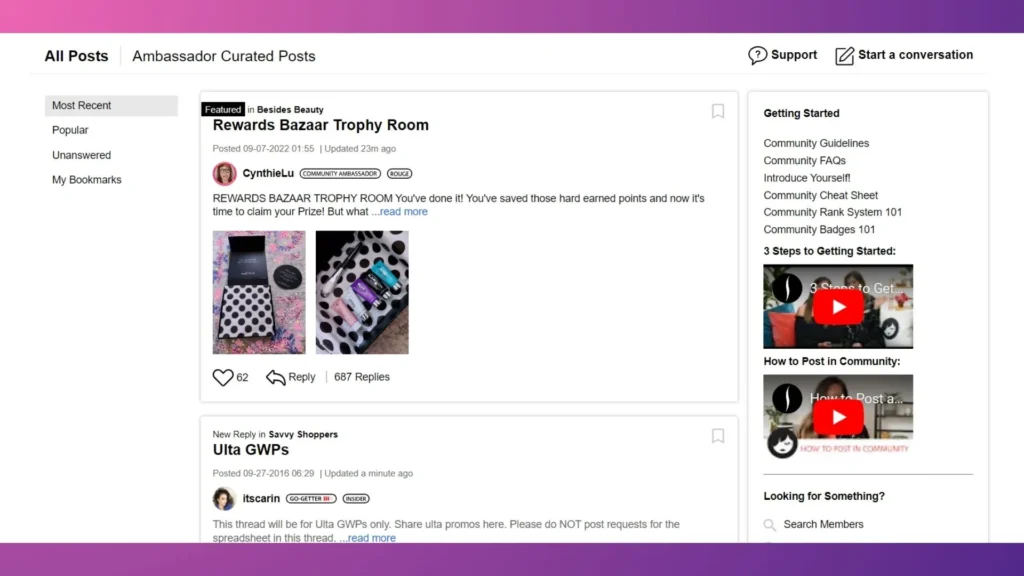
Common Challenges in Loyalty Marketing & Ways To Overcome It
There can be problems with even the best-planned reward program. The following are some usual problems you should be aware of:
- Maintaining Customer Interest:
A survey by Collinson Latitude found that 85% of people would rather connect with their favorite reward brands than in person. But the joy that comes with a new rewards program can wear off over time.
This could be avoided by providing your customers with exciting rewards and regular updates to keep them engaged in your program.
- Rewards vs. Profitability:
To get and keep people, it’s important to offer good rewards, but there’s a fine line to walk. Giving out too many awards can cut into your profits.
The important thing is to find a middle ground between giving your customers benefits they’ll value and making sure your program can keep going. Think about a tiered system where customers get better rewards as they interact with your business more.
Future Trends In Loyalty Marketing
Building trust and rewarding involvement are two things that will never change, even while how we do them changes. So, what does the future hold for loyalty marketing? This section covers AI-powered customization and value-driven incentives.
Evolving Consumer Expectations
According to Catalyst research, the proportion of consumers who hold businesses responsible for price hikes has risen by 8%. This suggests that value is receiving greater attention. These days, people seek more than just bargains.
Here are some techniques to develop trust amid a tough economy with suspicious consumers:
- Transparency & Empathy:
People are more likely to trust brands that are honest about prices and show how hard it is for them to make ends meet. Loyalty programs can offer adjustable reward systems, focused sales on necessary items, and clear information about the program’s benefits.
- Personalization is King:
We no longer have reward systems that work for everyone. Customers expect an experience that is tailored to their specific wants and needs. Customer loyalty marketing needs to use data to send each customer messages, rewards, and discounts that are more relevant to them.
Adapting to these evolving expectations is crucial for the future of loyalty marketing.
The Rise Of AI-powered Personalization
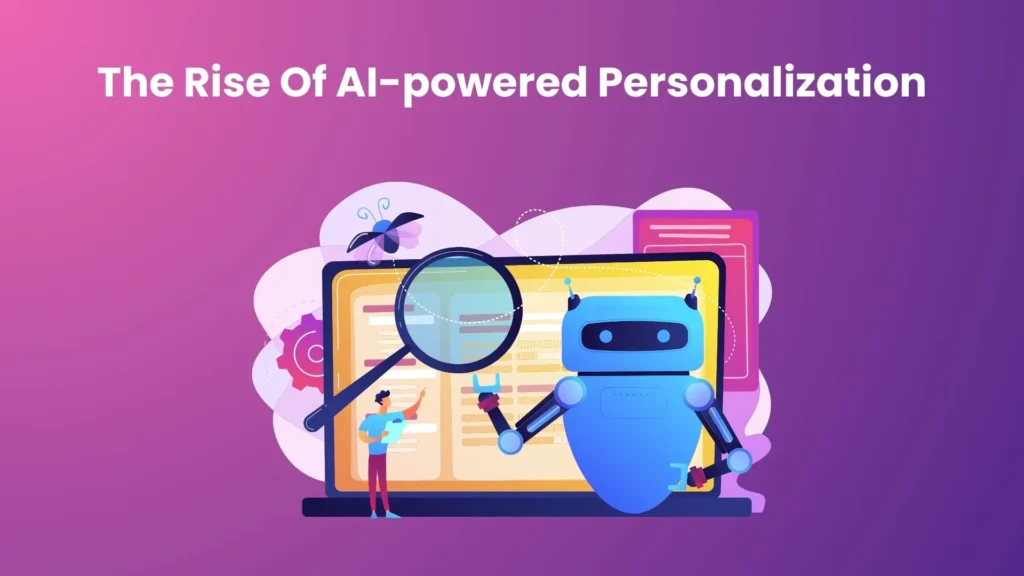
Grocery Doppio did a study and found that a big 76% of shoppers are ready to give their information to have a better event.
Lots of data is available, but artificial intelligence (AI) is great at finding hidden patterns. As a result, reward systems can make sure that every customer has a memorable experience.
According to the 2024 Digital IT Outlook, food stores will spend 7.3% of their IT budget on digital deals, awards, and services. All these things are done to bring in new customers, keep old ones, keep them interested, and give them real value.
Final thoughts
Finally, customer loyalty marketing is more than just giving people points and deals. It’s about building brand loyalty and customer advocacy with loyalty programs. Use these strategies to create a reward program that develops trust, engages consumers, and secures long-term economic success.
Want to find the Shopify store loyalty awards app? We have what you need at BON Loyalty!
This Shopify loyalty app lets you construct a program with over 18 methods to earn points, total brand customization, VIP levels, and a strong referral program.
If you want to learn more about customer retention strategies, check out our blog.
Lindsey Nguyen is a Content Marketing Specialist at BON Loyalty, specializing in digital marketing and eCommerce. At BON Loyalty, she crafts content that empowers Shopify store owners to build and sustain thriving customer relationships through innovative loyalty programs. Her articles, often featured on the BON Loyalty blog, provide valuable strategies and insights that help businesses enhance customer loyalty and increase customer lifetime value.
